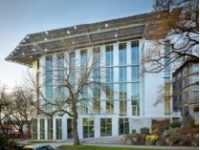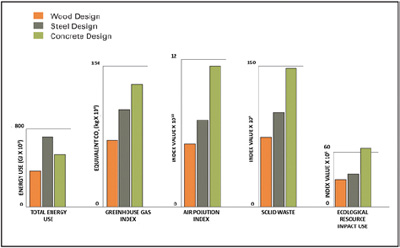Wood and LEED v4
Learning Objectives:
- Explain the intent and goals of forest products earning an EPD.
- Understand the necessary steps manufacturers must undertake for products to earn an EPD.
- Name programs aimed at providing specifiers with the information necessary to identify sustainable products.
- Explain the potential and limitations of product transparency with regard to sustainability.
Credits:

A great example of structural wood in action, the highly sustainable, net-zero Bullitt Center in Seattle uses 100 percent FSC-certified wood, including glulams as the structural elements, and heavy timbers and 2 feet by 6 feet ceilings as finished surfaces.
Of course, one of LEED’s biggest changes has been a bold move toward product transparency and disclosure, namely a fuller incorporation of life-cycle analysis and the introduction of Environmental Product Declarations (EPD) and Health Product Declarations (HPD).
Defined as a third-party verified report of the environmental impacts associated with a specific product or material throughout its full life cycle, in accordance with ISO 14025, trade associations and building product manufacturers are busy creating EPDs both to demonstrate increase their eligibility for specification in LEED v4 projects.
Considered to be a highly sustainable building material, the wood products industry has been very much a part of this effort to gather the necessary environmental data, publish EPDs and HPDs and support LEED v4 changes.
Architects looking to continue bringing the warmth of wood to their designs will benefit from a more in-depth understanding of v4’s upgraded wood-related credits, of wood EPD development and of how Forest Stewardship Council-certified wood factors into new LEED v4 requirements.
LEED 2009 to LEED v4
In LEED 2009, the selection of wood products was recognized with a Certified Wood, Regional Material and Low-Emitting Materials-Composite Wood and Agrifiber Products credit for a total of three points. In addition, projects could pick up another voluntary credit by specifying Forest Stewardship Council or Sustainable Agriculture Network-certified products.
Fortunately for forest product fans, the use of wood products can now contribute up to 12 points, accounting for more than 10 percent of LEED v4’s total credits. In fact, according to the U.S. Green Building’s Council’s recently released Industry Materials Brief on Forest Products, the “use of wood as a building material is among the most highly incentivized strategies in LEED.”
In particular, wood products now qualify for credits in the following five categories:
- Building Life-Cycle Impact Reduction. Because materials and products with comparatively low environmental impacts fare well in v4’s whole building life-cycle credit, wood is a front-line contender. It’s renewable, creates habitat, sequesters carbon and has numerous applications in building projects.
- Building Product Disclosure and Optimization—Environmental Product Declarations.
- Building Product Disclosure and Optimization— Sourcing of Raw Materials. Projects can either specify wood from suppliers and manufacturers with a Corporate Sustainability Report or choose new wood products certified by the Forest Stewardship Council, Sustainable Agriculture Network or equivalent standard to contribute toward this credit.
- Building Product Disclosure and Optimization—Material Ingredients. Untreated and unfinished wood products as “inherently non-emitting sources” can contribute toward this credit.
- Low-Emitting Materials. Untreated and unfinished wood products are also in line with this credit’s requirements.
EPDs: A Closer Look

According to a Naturally:Wood, wood performs better than concrete and steel in terms of embodied energy, air and water pollution, carbon footprint and global warming potential.
Benefitting from legwork done by Canadian organization FPInnovations, an ISOcompliant EPD program operator serving the forest products industry, “A Product Category Rule for North American Structural and Architectural Wood Products,” most recently updated in May 2013, is available for wood product manufacturers to use to jump start a life-cycle analysis and EPD development for their products.
FPInnovations initially based the development of these North American PCRs on Product Category Rules released by the Norwegian EPD Foundation and German Institute for Construction and Environment in 2009, according to Robert Glowinski, president and CEO, American Wood Council, Washington, D.C. Changes were then made to reflect conditions, terminology and data unique to North American wood products, which was ultimately verified by UL Environment.
“The resulting parameters reflect the generally accepted practices of both North American and international experts, including the U.S. Environmental Protection Agency and the Intergovernmental Panel on Climate Change,” he reports.
Based upon these PCRs, wood product trade associations such as the American Wood Council (AWC) and the National Wood Flooring Association have worked to develop generic EPDs for the industry.
For example, available at http://www.awc.org/greenbuilding/epd.php, AWC has published EPDs and Transparency Briefs – which summarize key EPD data – for the following product types: softwood lumber, softwood plywood, oriented strand board, glued laminated timbers, laminated veneer lumber, wood I-joists, redwood decking, medium density fiberboard and particleboard.
Although individual companies are only starting to create their own product-specific EPDs, the wood products industry is considered to be ahead of other major building product sectors in this regard.
“The [wood products] industry has done far more than any other to develop PCRs and EPDs, with most manufacturers participating,” confirms Jim Bowyer, director, responsible materials program, whose Minneapolis-based firm Dovetail Partners specializes in disseminating non-biased environmental information.
That said, the forest products industry has also been the subject of criticism with regard to how the environmental impacts of wood products are being established and measured.
“My concern with PCRs is that the [forest] industry has jumped in to define them without the benefit of the expertise of the design community to assure that the PCRs contain stringent rules that really bring value to the project,” states Peggy White, CCS, CCCA, LEED AP, BD+C, White+GreenSpec Architectural Specifications, San Jose, Calif. “Then when the EPDs are developed by manufacturers using skewed PCRs, things are further watered down.”
Even more assertive, Jason Grant, LEED AP, principal, Jason Grant Consulting, Sebastopol, Calif., relates, “Major environmental groups, including Sierra Club, have big problems with the current wood PCR because it ignores the environmental impacts of logging on ecosystems, biodiversity, soil and water quality, and fails to include forest-based, biogenic carbon in its carbon accounting.”
Essentially, this is all based on the issue that current wood PCRs do not require sitespecific environmental impacts of forestry operations to be measured. Included in the PCRs are the following impact categories: global warming potential, acidification potential, eutrophication potential, smog creation potential and ozone depletion potential, in addition to accounting for total primary energy consumption and material resources consumption.
However, as spelled out in a white paper, “Understanding EPDs for Wood, Current Problems and Future Possibilities,” authored by The Sierra Club Forest Certification and Green Building Team, some land use-related impact categories which have not been included are forest disturbance, stream disturbance and the elimination of wildlife habitat.
The report also points out that responsible forestry is not rewarded through current PCRs as wood products associated with environmentally destructive forestry practices can still manage to fare well under these product rules.
In all fairness, Grant acknowledges that environmental activists are also pressuring organizations and companies in other building product sectors to uphold certain standards of environmental responsibility and evaluation. However, it seems to be more pronounced with forest products as their extraction has larger and broader impacts on the land and terrestrial ecosystems, as opposed to other materials whose land-based impacts from mining and drilling are more limited. As such, a greater majority of environmental impacts for other industries are coming through the manufacturing process, which is better captured through an LCA.
“So while it is fairly straightforward for [the forest products] industry to do LCAs and EPDs to the PCR, there are serious questions as to the validity and the completeness of the information the EPDs provide. In fact, our feeling is that they may hide as much or more than they reveal, which is downright Orwellian given that this is supposed to be about ‘transparency,’” concludes Grant.
White agrees, stating, “An LCA can be too easily manipulated by the selection of criteria one wants to evaluate, so to me, it’s just not valuable—yet. Maybe someday.”
In defense, Glowinski emphasizes the fact that the wood product PCR development strictly followed the ISO consensus process, and that the EPD’s underlying LCAs were produced by the academic group, the Consortium for Research on Renewable Industrial Materials.
“The EPDs, including their data as well as conformance to the rules and PCR, were then verified by UL Environment, and the impact categories selected mirror those required by the USGBC in LEED v4,” he relates.
To address the concerns regarding the absence of certain environmental impact categories in the current wood PCRs and other product categories, particularly related to land-use issues and climate change, an emerging national standard for LCA (currently in draft form under the ANSI process) has been developed through the Leonardo Academy. “The LEO-SCS-002 standard will allow for increased transparency of EPDs by considering over 20 impact categories and incorporating site-specific data into the LCA models,” says Keith Killpack, manager of life cycle services for SCS Global Services, an ISO 14025 program operator for LEED v4 compliant EPDs and one of the leading proponents of the new standard. “The new LEO-SCS-002 standard goes beyond LEED v4 compliance, allowing for more thorough comparative analyses of different building products based on a fuller suite of environmental impact areas. It also serves as the basis for LCA-based Environmentally Preferable Product certification.”










